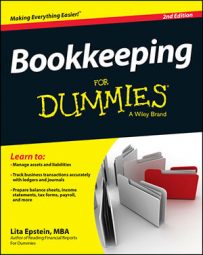Each and every account has its purpose in bookkeeping, but all accounts certainly aren’t created equal. For most companies, some accounts are more essential than others, so in case you’re having trouble knowing where to start your account setup and what’s necessary, this list looks at the top must-have accounts for bookkeepers.
Cash accounts
All your business transactions pass through the Cash account, which is so important that you actually need two journals, Cash Receipts and Cash Disbursements to track the activity. As the bookkeeper, it’s your responsibility to be sure that all cash — whether it’s coming into the business or being sent out — is handled and recorded properly in the Cash account.
Accounts receivable
If your company sells its products or services to customers on store credit, you definitely need an Accounts Receivable account. This is the account where you track all money due from customers. As the bookkeeper, keeping Accounts Receivable up-to-date is critical to be sure that you send timely and accurate bills to customers.
Inventory
Every company must have products to sell. Those money-making products must be carefully accounted for and tracked because it’s the only way a business knows what it has on hand to sell. As the bookkeeper, you contribute to this process by keeping accurate inventory records in an Inventory account. The numbers you have in your books are periodically tested by doing physical counts of the inventory on hand.
Accounts payable
No one likes to send money out of the business, but you can ease the pain and strain by tracking and paying bills in your Accounts Payable account. You certainly don’t want to pay anyone twice, but you also want to be sure you pay bills on time or else your company may no longer get the supplies, inventory, or other things needed to operate the business.
Suppliers often penalize late-paying companies by cutting them off or putting them on cash-only accounts. On the flip side, if you pay your bills early, you may be able to get discounts and save money with suppliers, so the early bird definitely gets the worm.
Loans payable
There’s bound to come a time when your company needs to purchase major items such as equipment, vehicles, and furniture. Unfortunately, you may find that you don’t have the money to pay for such purchases.
The solution is to take on long-term loans to be paid over more than a 12-month period. The Loans Payable account allows you to monitor the activity on these loans, in order to get and keep the best rates, and to make all loan payments on time and accurately.
Sales
No business can operate without taking in cash, mostly through sales of the company’s products or services. The Sales account is where you track all incoming revenue collected from these sales. Recording sales in a timely and accurate manner is a critical job of yours because otherwise you can’t know how much revenue has been collected every day.
Purchases
Purchases are unavoidable. In order to have a tangible product to sell, your company has to either manufacture the product, in which case you have to purchase raw materials, or purchase a finished product from a supplier. In the Purchases account, you track the purchases of any raw materials or finished goods. The Purchases account is a key component in calculating Cost of Goods Sold, which you subtract from Sales to find your company’s gross profit.
Payroll expenses
It’s a fact of business that you must pay employees to get them to stay around. No matter how much you beg, few people want to work for nothing. To keep up with what is for many businesses their biggest expense, you track all money paid to employees in the Payroll Expenses account.
Accurate maintenance of this account is essential because it ensures that all governmental reports are filed and payroll taxes are paid. And if you don’t take care of these responsibilities to the government, you’ll find yourself in some serious hot water.
Office expenses
One key expense that can drain a company’s profits is office expenses. From paper, pens, and paper clips to expenses related to office machinery, these expenses tend to creep up if not carefully monitored in the Office Expenses account.
Owner’s equity
Accounts related to owner’s equity, which is the amount each owner puts into the business, vary depending upon the type of business for which you keep the books. Many small businesses are owned by one person or a group of partners; they’re not incorporated, so no stock shares exist to apportion ownership.
Instead, money put into the business by each of the owners is tracked in Capital accounts, and any money taken out of the business by the owners appears in Drawing accounts. In order to be fair to all owners, you must carefully track all Owner’s Equity accounts.
Retained earnings account
The Retained Earnings account tracks any profits made by the company that are reinvested for growing the company and not paid out to company owners. This account is cumulative, which means it shows a running total of earnings that have been retained since the company opened its doors.
Although managing this account doesn’t take a lot of time, the ongoing accuracy of the Retained Earnings account is important to investors and lenders who want to track how well the company is doing.

